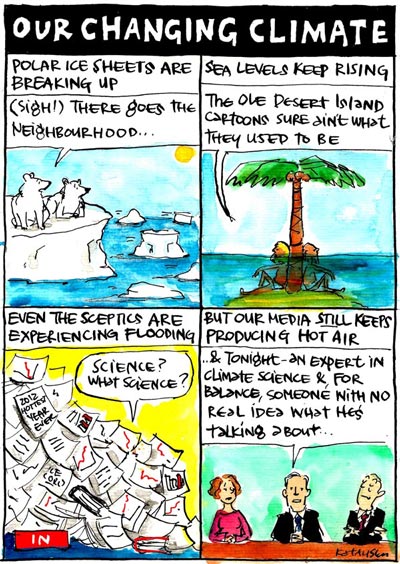
"Soon after Christy's testimony, Roger Pielke Jr. and Steve McIntyre weighed in by attacking the largely correct testimony from Christopher Field, while turning blind eye to Christy's grossly misleading testimony that contained myths regarding extreme weather events."
So sets the stage for Pielke Jr and McIntyre Assist Christy's Extreme Weather Obfuscation by Albatross and Dana. Using the metric of number of comments posted, it is the most popular of the articles posted on SkS last week.

The science in Hansen’s study is excellent “and reframes the question,” said Andrew Weaver, a climate scientist at the University of Victoria in British Columbia who was a member of the Nobel Prize-winning international panel of climate scientists that issued a series of reports on global warming.
“Rather than say, ‘Is this because of climate change?’ That’s the wrong question. What you can say is, ‘How likely is this to have occurred with the absence of global warming?’ It’s so extraordinarily unlikely that it has to be due to global warming,” Weaver said.
Source: Study by ‘global warming godfather’: Texas drought, Europe heat waves are climate change, AP/Washington Post
Ice age: An ice age or glacial period is characterised by a long-term reduction in the temperature of the Earth’s climate, resulting in growth of continental ice sheets and mountain glaciers (glaciation).
Ice cap: A dome shaped ice mass, usually covering a highland area, which is considerably smaller in extent than an ice sheet.
Ice core: A cylinder of ice drilled out of a glacier or ice sheet.
Ice sheet: A mass of land ice that is sufficiently deep to cover most of the underlying bedrock topography, so that its shape is mainly determined by its dynamics (the flow of the ice as it deforms internally and/or slides at its base). An ice sheet flows outward from a high central ice plateau with a small average surface slope. The margins usually slope more steeply, and most ice is discharged through fast-flowing ice streams or outlet glaciers, in some cases into the sea or into ice shelves floating on the sea. There are only three large ice sheets in the modern world, one on Greenland and two on Antarctica, the East and West Antarctic Ice Sheets, divided by the Transantarctic Mountains. During glacial periods there were others.
Ice shelf: A floating slab of ice of considerable thickness extending from the coast (usually of great horizontal extent with a level or gently sloping surface), often filling embayments in the coastline of the ice sheets. Nearly all ice shelves are in Antarctica, where most of the ice discharged seaward flows into ice shelves.
Ice stream: A stream of ice flowing faster than the surrounding ice sheet. It can be thought of as a glacier flowing between walls of slower-moving ice instead of rock.
Due to a technical glitch, SkS daily emails were suspended for a few weeks. John Cook has now fixed the glitch and resumed sending out the daily email. Thanks to SkS readers for their patience on this matter.
British Antarctic Survey (BAS) is a component of the Natural Environment Research Council (NERC). Based in Cambridge, United Kingdom, it has, for over 60 years, undertaken the majority of Britain's scientific research on and around the Antarctic continent. It now shares that continent with scientists from over thirty countries.
BAS employs over 400 staff, and supports three stations in the Antarctic, at Rothera, Halley and Signy, and two stations on South Georgia, at King Edward Point and Bird Island. The Antarctic operations and science programmes are executed and managed from Cambridge, and rely on a wide-ranging team of professional staff.
Ice-strengthened ships sustain the Antarctic operations. RRS James Clark Ross has advanced facilities for oceanographic research. RRS Ernest Shackleton is primarily a logistics ship used for the re-supply of stations. Four Twin Otter aircraft fitted with wheels and skis are operated from Rothera and Halley, while a wheels-only Dash-7 aircraft provides the inter-continental air-link from Rothera to the Falkland Islands, and flies inland to blue ice runways.
The current BAS science research strategy is called Polar Science for Planet Earth (PSPE). The strategy was based on proposals from staff and consists of 6 integrated programmes. In addition the competitive Antarctic Funding Initiative (AFI) provides access to Antarctica for BAS and NERC staff and the UK university community.
The total BAS budget for 2011-2012 is £48 million. Of this, £13 milllion is spent on the science programme, and £35 million spent on supporting the science, which includes the costs of running the ships, aircraft and research stations. The high costs involved highlight the challenges BAS faces in operating within a harsh and remote environment.
Posted by John Hartz on Monday, 13 August, 2012
 |
The Skeptical Science website by Skeptical Science is licensed under a Creative Commons Attribution 3.0 Unported License. |